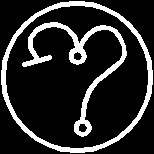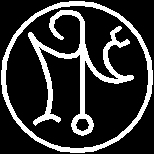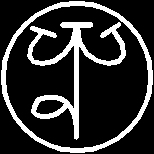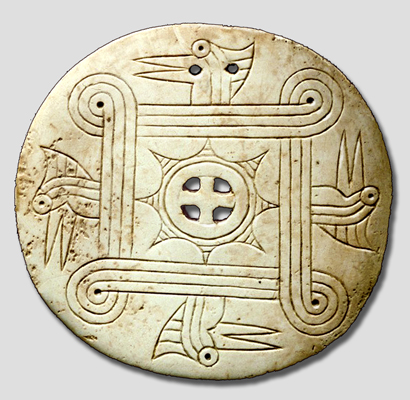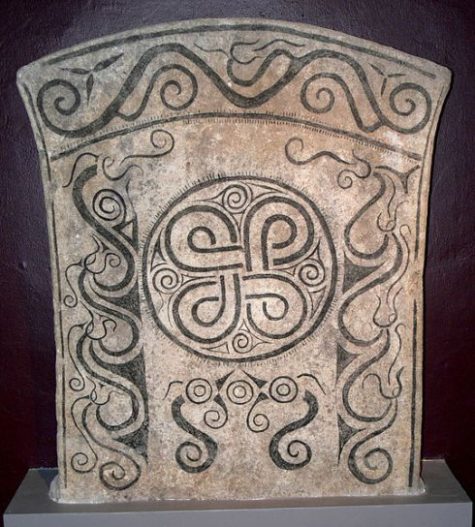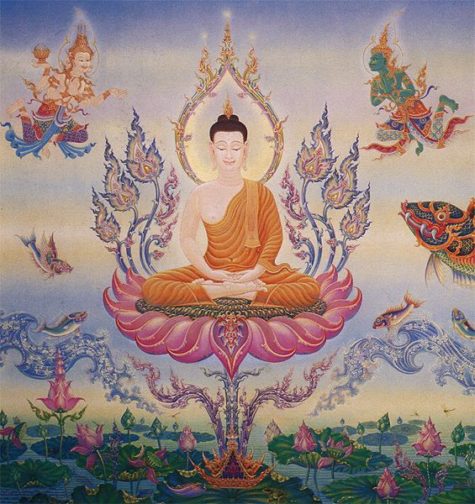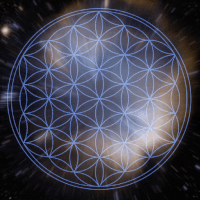Asaruludu
From the Fifty Names of Marduk in the Necronomicon Spellbook.
The Seventh Name is ASARULUDU.
Wielder of the Flaming Sword, oversees the Race of Watchers at the bidding of the Elder Gods. He ensures the most perfect safety, especially in dangerous tasks undertaken at the behest of the Astral Gods, his Word is BANMASKIM.
Like the Angel in Genesis, this Spirit protects a place, a home or temple, from negative psychic and magickal attacks. Like the Sixth Spirit, merely the pronunciation of his Word BANMASKIM is sufficient to dispel hostile influences when shouted to the four quarters. Maskim and Rabisu are the names of ancient Sumerian demons.
Important note:
“The Signs and Powers may be summoned after the Priest has ascended to that step on the Ladder of Lights and gained entrance to that Sacred City. The Signs should be engraved on parchment or sealed in clay and placed upon the altar at the Calling. And in the perfumes should be of cedar, and strong, sweet-smelling resins. And the Calling be to the North.”
More information:
According to Sumerian mythology, Marduk was the God who defeated the Ancient Ones long before the creation of matter as we know it.
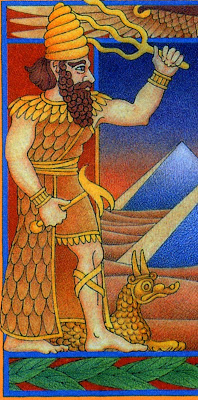 Against him in battle were the fierce TIAMAT, KINGU, and AZAG-THOTH. Once he had destroyed these demons, he created the universe from the flesh of TIAMAT, and humanity from the blood of KINGU mixed with his own breath.
Against him in battle were the fierce TIAMAT, KINGU, and AZAG-THOTH. Once he had destroyed these demons, he created the universe from the flesh of TIAMAT, and humanity from the blood of KINGU mixed with his own breath.
You will come across these names in the description of the Fifty Names, which were titles given to Marduk by the Elder Gods after he had helped them to defeat the Ancient Ones.
Related links:
- Pagan Calendar – Marduk’s Feast Day
- The Powers That Be – Marduk The God
- Widdershins – Marduk Legends and Stories, the original translation of the Enûma Eliš, and the Fifty Names of Marduk as originally given in the ancient tablets.
Nariluggaldimmerankia
From the Fifty Names of Marduk in the Necronomicon Spellbook.
The Sixth Name is NARILUGGALDIMMERANKIA or NARI-LUGALDIMMNKIA
The Watcher of the IGIGI and the ANNUNAKI. Sub-Commander of the Wind Demons. He will put to flight any maskim who haunt thee, and the foe of the rabisu. None may pass into the World Above or the World Below without his knowledge. His word is BANRABISHU.
A good Spirit for warding off feelings of aggravation and irritation, as well as the gnawing feelings of dread that sometimes come in the wee hours of the morning, when you feel lost and alone. Merely the pronunciation of the Word BANRABISHU at these times is sufficient to dispel most of these negative emotions. To be said with force and strength in the four directions.
Important note:
“The Signs and Powers may be summoned after the Priest has ascended to that step on the Ladder of Lights and gained entrance to that Sacred City. The Signs should be engraved on parchment or sealed in clay and placed upon the altar at the Calling. And in the perfumes should be of cedar, and strong, sweet-smelling resins. And the Calling be to the North.”
More information:
According to Sumerian mythology, Marduk was the God who defeated the Ancient Ones long before the creation of matter as we know it.
 Against him in battle were the fierce TIAMAT, KINGU, and AZAG-THOTH. Once he had destroyed these demons, he created the universe from the flesh of TIAMAT, and humanity from the blood of KINGU mixed with his own breath.
Against him in battle were the fierce TIAMAT, KINGU, and AZAG-THOTH. Once he had destroyed these demons, he created the universe from the flesh of TIAMAT, and humanity from the blood of KINGU mixed with his own breath.
You will come across these names in the description of the Fifty Names, which were titles given to Marduk by the Elder Gods after he had helped them to defeat the Ancient Ones.
Related links:
- Pagan Calendar – Marduk’s Feast Day
- The Powers That Be – Marduk The God
- Widdershins – Marduk Legends and Stories, the original translation of the Enûma Eliš, and the Fifty Names of Marduk as originally given in the ancient tablets.
Luggaldimmerankia
From the Fifty Names of Marduk in the Necronomicon Spellbook.
The Fifth Name is LUGGALDIMMERANKIA or LUCALDIMMFRANKIA
Puts order into CHAOS. Made the Waters aright. Commander of Legions of Wind Demons who fought the Ancient TIAMAT alongside MARDUK KURIOUS. The word used at his Calling is BANUTUKKU.
This seal has proven useful when confusion has taken hold of the mind and no way can be seen to end the mess a life is in. To sharpen your perception of a problem and to discover a hidden answer, one you have constantly overlooked, call upon this spirit and a cloud will lift from your heart and mind and the solution to an important problem will reveal itself in all its simplicity.
More information:
“The Signs and Powers may be summoned after the Priest has ascended to that step on the Ladder of Lights and gained entrance to that Sacred City. The Signs should be engraved on parchment or sealed in clay and placed upon the altar at the Calling. And in the perfumes should be of cedar, and strong, sweet-smelling resins. And the Calling be to the North.”
More information:
According to Sumerian mythology, Marduk was the God who defeated the Ancient Ones long before the creation of matter as we know it.
 Against him in battle were the fierce TIAMAT, KINGU, and AZAG-THOTH. Once he had destroyed these demons, he created the universe from the flesh of TIAMAT, and humanity from the blood of KINGU mixed with his own breath.
Against him in battle were the fierce TIAMAT, KINGU, and AZAG-THOTH. Once he had destroyed these demons, he created the universe from the flesh of TIAMAT, and humanity from the blood of KINGU mixed with his own breath.
You will come across these names in the description of the Fifty Names, which were titles given to Marduk by the Elder Gods after he had helped them to defeat the Ancient Ones.
Related links:
- Pagan Calendar – Marduk’s Feast Day
- The Powers That Be – Marduk The God
- Widdershins – Marduk Legends and Stories, the original translation of the Enûma Eliš, and the Fifty Names of Marduk as originally given in the ancient tablets.
Barashakushu
From the Fifty Names of Marduk in the Necronomicon Spellbook.
The Fourth Name is BARASHAKUSHU.
Worker of Miracles. The kindest of the Fifty, and the most beneficent. The Word used at his Calling is BAALDURU.
Can be used in hopeless cases, when it seems that the whole world is against you or a loved one. When despair reaches its lowest depth, and a coldness constricts your soul, call forcefully upon BARASHAKUSHU will all your might and hope and your prayer will be answered in ways you cannot imagine.
Important note:
“The Signs and Powers may be summoned after the Priest has ascended to that step on the Ladder of Lights and gained entrance to that Sacred City. The Signs should be engraved on parchment or sealed in clay and placed upon the altar at the Calling. And in the perfumes should be of cedar, and strong, sweet-smelling resins. And the Calling be to the North.”
More information:
According to Sumerian mythology, Marduk was the God who defeated the Ancient Ones long before the creation of matter as we know it.
 Against him in battle were the fierce TIAMAT, KINGU, and AZAG-THOTH. Once he had destroyed these demons, he created the universe from the flesh of TIAMAT, and humanity from the blood of KINGU mixed with his own breath.
Against him in battle were the fierce TIAMAT, KINGU, and AZAG-THOTH. Once he had destroyed these demons, he created the universe from the flesh of TIAMAT, and humanity from the blood of KINGU mixed with his own breath.
You will come across these names in the description of the Fifty Names, which were titles given to Marduk by the Elder Gods after he had helped them to defeat the Ancient Ones.
Related links:
- Pagan Calendar – Marduk’s Feast Day
- The Powers That Be – Marduk The God
- Widdershins – Marduk Legends and Stories, the original translation of the Enûma Eliš, and the Fifty Names of Marduk as originally given in the ancient tablets.
Marutukku
From the Fifty Names of Marduk in the Necronomicon Spellbook.
The Third Name is MARUTUKKU
Master of the Arts of Protection, chained the Mad God at the Battle. Sealed the Ancient Ones in the Caves, behind the Gates. Possesses the ARRA star.
To be used especially when performing any occult ceremony in which there is danger, such as the invocation of demonic forces. The ARRA star is a five-pointed Pentagram, and is the universal symbol of protection. Protects the soul as well as the body.
Important note:
“The Signs and Powers may be summoned after the Priest has ascended to that step on the Ladder of Lights and gained entrance to that Sacred City. The Signs should be engraved on parchment or sealed in clay and placed upon the altar at the Calling. And in the perfumes should be of cedar, and strong, sweet-smelling resins. And the Calling be to the North.”
More information:
According to Sumerian mythology, Marduk was the God who defeated the Ancient Ones long before the creation of matter as we know it.
 Against him in battle were the fierce TIAMAT, KINGU, and AZAG-THOTH. Once he had destroyed these demons, he created the universe from the flesh of TIAMAT, and humanity from the blood of KINGU mixed with his own breath.
Against him in battle were the fierce TIAMAT, KINGU, and AZAG-THOTH. Once he had destroyed these demons, he created the universe from the flesh of TIAMAT, and humanity from the blood of KINGU mixed with his own breath.
You will come across these names in the description of the Fifty Names, which were titles given to Marduk by the Elder Gods after he had helped them to defeat the Ancient Ones.
Related links:
- Pagan Calendar – Marduk’s Feast Day
- The Powers That Be – Marduk The God
- Widdershins – Marduk Legends and Stories, the original translation of the Enûma Eliš, and the Fifty Names of Marduk as originally given in the ancient tablets.
Marukka
From the Fifty Names of Marduk in the Necronomicon Spellbook.
The Second Name is MARUKKA.
Knows all things since the beginning of the World. Knows all secrets, be they human or divine, and is very difficult to summon. The Priest should not summon him unless he is clean of heart and spirit, for this Spirit shall know his innermost thoughts.
This warning should, of course, be taken seriously. Can be useful in an emergency situation when the knowledge of some secret thing is important to life or limb, but a time of purification should be observed at any rate after the Spirit is summoned. There is no word for this spirit. It must be summoned by the force of your desire.
Important note:
“The Signs and Powers may be summoned after the Priest has ascended to that step on the Ladder of Lights and gained entrance to that Sacred City. The Signs should be engraved on parchment or sealed in clay and placed upon the altar at the Calling. And in the perfumes should be of cedar, and strong, sweet-smelling resins. And the Calling be to the North.”
More information:
According to Sumerian mythology, Marduk was the God who defeated the Ancient Ones long before the creation of matter as we know it.
 Against him in battle were the fierce TIAMAT, KINGU, and AZAG-THOTH. Once he had destroyed these demons, he created the universe from the flesh of TIAMAT, and humanity from the blood of KINGU mixed with his own breath.
Against him in battle were the fierce TIAMAT, KINGU, and AZAG-THOTH. Once he had destroyed these demons, he created the universe from the flesh of TIAMAT, and humanity from the blood of KINGU mixed with his own breath.
You will come across these names in the description of the Fifty Names, which were titles given to Marduk by the Elder Gods after he had helped them to defeat the Ancient Ones.
Related links:
- Pagan Calendar – Marduk’s Feast Day
- The Powers That Be – Marduk The God
- Widdershins – Marduk Legends and Stories, the original translation of the Enûma Eliš, and the Fifty Names of Marduk as originally given in the ancient tablets.
Marduk
From the Fifty Names of Marduk in the Necronomicon Spellbook.
The First Name is MARDUK.
The Lord of Lords, Master of Magicians. His name should not be called except when no other will do, and it is the most terrible responsibility to do so. The word of his calling is DUGGA.
This, the first name of MARDUK, should only be used when life is threatened. It is not wise to use it on any other occasion, of flippantly in way. To do so would be to render the other seals and names worthless, for MARDUK would abandon you to your fate.
Important note:
“The Fifty Names with their Signs and Powers may be summoned after the Priest has ascended to that step on the Ladder of Lights and gained entrance to that Sacred City. The Signs should be engraved on parchment or sealed in clay and placed upon the altar at the Calling. And in the perfumes should be of cedar, and strong, sweet-smelling resins. And the Calling be to the North.”
More information:
According to Sumerian mythology, Marduk was the God who defeated the Ancient Ones long before the creation of matter as we know it.
 Against him in battle were the fierce TIAMAT, KINGU, and AZAG-THOTH. Once he had destroyed these demons, he created the universe from the flesh of TIAMAT, and humanity from the blood of KINGU mixed with his own breath.
Against him in battle were the fierce TIAMAT, KINGU, and AZAG-THOTH. Once he had destroyed these demons, he created the universe from the flesh of TIAMAT, and humanity from the blood of KINGU mixed with his own breath.
You will come across these names in the description of the Fifty Names, which were titles given to Marduk by the Elder Gods after he had helped them to defeat the Ancient Ones.
Related links:
- Pagan Calendar – Marduk’s Feast Day
- The Powers That Be – Marduk The God
- Widdershins – Marduk Legends and Stories, the original translation of the Enûma Eliš, and the Fifty Names of Marduk as originally given in the ancient tablets.
The Cox Mound Gorget
The Cox Mound, or Woodpecker, gorget style is a particularly beautiful and enduring symbol of Tennessee’s prehistoric inhabitants. A gorget was a pendant, or personal adornment, worn around the neck as a badge of rank or insignia of status and was thought to be symbolic of both earthly and supernatural powers. A variety of gorget styles, or designs, are known. As a class of artistic expression, this type of artifact falls within the Southeastern Ceremonial Complex, formerly known as the Southern Cult.
Just over thirty Cox Mound-style gorgets have been found since the late nineteenth century, primarily from prehistoric Mississippian stone box graves and villages along the lower Tennessee, Cumberland, Duck, Harpeth, and Buffalo Rivers of Middle Tennessee, and the middle Tennessee River valley of northern Alabama. As a result of the frequent mortuary association of Cox Mound gorgets with certain pottery types, namely Matthews Incised, as well as other artifacts, it has been postulated that Cox Mound gorgets date to the period A.D. 1250-1450. One rich grave from the famous burial mound at the Castalian Springs site in Sumner County produced two Cox Mound gorgets.
Typically, Cox Mound gorgets were manufactured on exotic marine shell and were white in color. Other materials, such as black slate in Putnam County and human skull fragments in Hardin County, were used rarely. Engraving the intricate design on the hard shell or slate without metal tools took many hours of skilled labor and is thought to have been a winter activity.
A Cox Mound gorget has three important iconographic elements. In the center is a cross inside a rayed circle or sun motif. The cross is symbolic of the sacred, or council, fire. The sun represents the sky deity and/or mythical ancestors. Surrounding the cross and sun is a scroll-like design element known as the looped square. This feature may represent wind, or possibly the litter on which subordinates carried a chief.
Typically the looped square is composed of four lines, but in some cases only three lines are used. Four crested bird heads, which most scholars interpret as woodpeckers, are found on the outer edge. The woodpecker heads always are oriented in a counterclockwise direction, suggestive of the prehistoric Native American swastika.
The woodpecker, like the falcon, was probably a symbol of war to the prehistoric Mississippian Indians. The war symbolism of the bird probably derived from the red head of the bird, which resembled a bloodied scalping victim. The Cherokees associated the red-headed woodpecker with danger and war, and the woodpecker was always invoked for aid by the ball game players. The bird’s pecking is similar to an Indian warrior striking the war post at the Victory dance. For the Cherokees, the color red is associated with male attractiveness and fertility, as well as bravery and war. Groups of woodpeckers are thought to be a sign of war to the Creeks and Seminoles. While war is typically associated with males in Native American society, it is important to note that Cox Mound gorgets have been found in both male and female burials.
Other interpretations include the identification of the four woodpeckers as the four thunders at the world quarters, and a folklorist has speculated recently that the Cox Mound gorget style is a prehistoric expression of the Yuchi myth of the Winds. Cox Mound gorgets are displayed by the Tennessee State Museum and Pinson Mounds State Archaeological Area.
Source: Tennessee Encyclopedia
The Looped Square
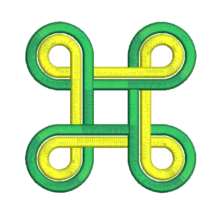 The looped square (⌘) is a symbol consisting of a square with outward pointing loops at its corners. Also called a Shield Knot, it is a universal symbol of protection, seen in all cultures around the world.
The looped square (⌘) is a symbol consisting of a square with outward pointing loops at its corners. Also called a Shield Knot, it is a universal symbol of protection, seen in all cultures around the world.
Although it takes different forms, the distinctive features that make it a powerful protecting charm are the square shape and the interlacing pattern.
One of the earliest known forms is from Mesopotamia and simply consists of a square with a loop at each corner. The same symbol appears in the Kabbalah as the “Shema,” used to invoke the four Archangels
It can also represent:
- Love
- Flow
- Infinity
- Flowing water
This ancient symbol belongs to a class of symbols which are called valknute in Norway. It goes by many names and has many different variations. The looped knot is used by several cultures, and remains in common use today.
In Finland, the symbol was painted or carved on houses and barns, and domestic utensils such as tableware, to protect them and their owners from evil spirits and bad luck. The symbol appears on a number of old objects in Northern Europe. It features prominently on a picture stone from Hablingbo, Gotland, Sweden, that was created between 400 and 600 AD.
In modern times, the symbol is commonly found in Ukraine, Belarus, Denmark, Estonia, Finland, Germany, Iceland, Latvia, Lithuania, Norway, and Sweden as an indicator of locations of cultural interest, beginning in the Scandinavian countries in the late 1960s. It is used as the place of interest marker on information signs and maps, a practice which started in Nordic countries in the late 1960s.
In Sweden, you might call it the sankthanskors symbol. There has been modern speculation that it was chosen for its resemblance to an aerial view of Borgholm Castle; however, the symbol is well-represented in Scandinavian artifacts that predate the current castle by centuries.
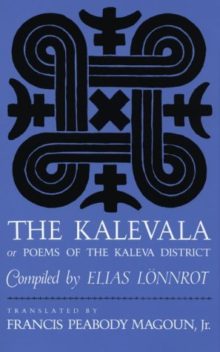 This symbol was also featured on the cover of a printing of The Kalevala, and is sometimes referred to as the Kalevala Symbol. The Kalevala or The Kalewala is a 19th-century work of epic poetry compiled by Elias Lönnrot from Karelian and Finnish oral folklore and mythology.
This symbol was also featured on the cover of a printing of The Kalevala, and is sometimes referred to as the Kalevala Symbol. The Kalevala or The Kalewala is a 19th-century work of epic poetry compiled by Elias Lönnrot from Karelian and Finnish oral folklore and mythology.
It is regarded as the national epic of Karelia and Finland and is one of the most significant works of Finnish literature. The Kalevala played an instrumental role in the development of the Finnish national identity, the intensification of Finland’s language strife and the growing sense of nationality that ultimately led to Finland’s independence from Russia in 1917. Kalevala Day is celebrated in Finland on February 28.
The Cox Mound Gorget, is a similar symbol which played a major role in the lives of Tennessee, Mississippi, and Alabama inhabitants as early as 1250 A.D. It has quite an interesting history, and has it’s own separate page here: The Cox Mound Gorget.
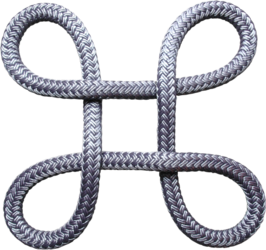 When the symbol is made with a rope, it is known as a Bowen knot. This is a traditional heraldic emblem also sometimes called a Shield Knot. The Bowen knot is a heraldic knot for the Bowen family crest.
When the symbol is made with a rope, it is known as a Bowen knot. This is a traditional heraldic emblem also sometimes called a Shield Knot. The Bowen knot is a heraldic knot for the Bowen family crest.
Other names for this symbol include:
- Saint John’s Arms
- Saint Hannes Cross
- Sankthanskor
- Hannunvaakuna
- Gorgon Loop
- Johanneskor
Today, you might know it as the “Apple command key” symbol. From its obscure Scandinavian roots, the Saint John’s Arms, or Looped Square vaulted into international fame during the 80s. Originally Apple computer utilized the “open apple” and “closed apple” as its command keys.
In 1984, when the Macintosh personal computer was introduced, Steve Jobs decided that using the apple for shortcut commands was denigrating the brand. According to Apple insider Andy Hertzfeld, when Jobs saw how many apple commands were in an early version of MacDraw he peremptorily told the design team, “There are too many Apples on the screen! It’s ridiculous! We’re taking the Apple logo in vain! We’ve got to stop doing that!”
The bitmap artist, Susan Kare, flipped through her dictionary of international symbols until she found one that easily translated into 16 bit-resolution. It was the looped square symbol—which the symbol dictionary said indicated camping grounds in Sweden.
Collected from various sources.
Lotus
The lotus is arguably one of the most important flower symbols on the planet, along with the lily and the rose. Both the otherworldly appearance of the flower and its growing circumstances make it obvious that the flower is very special. It’s therefore no surprise that the flower is one of the eight auspicious symbols in both Chinese and Tibetan Buddhist iconography.
This sensuous and extraordinary flower, with its perfect petals, rises imperiously from muddy swamps, its head above the dirty water. The symbolism applied by generations of Egyptian, Indian, and Chinese sages is obvious. First, the flower rises in complete perfection from the murky primal waters of creation. Next, the flower comes from the darkness into the light, woken by the Sun. Third, the lotus symbolizes the triumph of spirit over matter and is a metaphor for the journey to enlightenment.
Ancient Egyptians used the plant extensively as a symbol in the paintings and carvings left on the walls of temples and tombs.
 Because the lotus appears to retreat back into the water during the hours of darkness only to rise again above the surface of the water at dawn, the Egyptians saw it as a symbol of death and rebirth. It is now known the plant simply loses old blooms and adds new ones on a daily cycle, but it is still a potent reminder of reincarnation and the mysteries of the afterlife.
Because the lotus appears to retreat back into the water during the hours of darkness only to rise again above the surface of the water at dawn, the Egyptians saw it as a symbol of death and rebirth. It is now known the plant simply loses old blooms and adds new ones on a daily cycle, but it is still a potent reminder of reincarnation and the mysteries of the afterlife.
Priests and other religious leaders also brewed the flowers to make a tea with sedative and mild psychotropic effects, which heightened their sense for ritual work.
The tight bud of the flower is a symbol for the Universe. The flower is also an archetypal symbol for the vulva, and so is associated with the Goddess.
In all cultures the lotus carries within it a reminder of the elements. It has its seed within the earth; it grows in water; the blossom exists in air which also carries its fragrance; and the flower itself is awoken by the Sun, and therefore the element of fire which it also resembles, the curious central circle surrounded by the rays of petals.
In addition, the lotus has eight petals, symbolizing the four cardinal directions and the four intercardinal directions, as well as the rulers of the eight directions of the Universe, or Ashtadikpalas.
Buddhist studies use the lotus flower in guided meditations. The meditation instructs practitioners to imagine themselves as a tiny lotus seed that is deeply buried in the mud. While the mud is dirty and uncomfortable, the seed’s journey is to move calmly through the darkness and into the light. Once the seed completes the journey, it blossoms into the next stage of life. The lotus symbolizes growth and determination.
The Buddhist Lotus represents:
- Patience
- Purity
- Mysticism
- Direct Spiritual Contact
- Emptiness from Desire
- Victory over Attachments
- Enlightenment and the Bodhi State
- Love and Compassion for All Things
- Self-Awareness
- Faithfulness During Spiritual Development
- Rising Out of Suffering
These deep spiritual meanings gave rise to a way of sitting known as the Lotus position. The legs are crossed and tucked in a way that makes the bent knees look like the petals of a lotus. It is an important position in both Buddhist meditation and Hindu yoga practices. The soles of the feet are tucked away, which makes it a respectful position to sit in when visiting a temple where exposing the bottom of your feet is considered rude.
The lotus is also commonly depicted in mandalas, which are spiritual and artistic representations of divine energies and meditation aids in Buddhist traditions. The symbol of the lotus is often partially hidden in the traditional mandala, the petals forming a border that is both symbolic and decorative. The Buddha sits in the center of the eight-petaled lotus, detached from the material world with its cycle of death and rebirth.
In Hindu iconography, the lotus is seen as the base of the earth from which the holy mountains (such as Kailash and Meru) rise. The stalk of the flower is associated with the world axis which rises up through this sacred mountain.
The lotus is used as a symbol for each of the chakras, the number of petals relating to the role and function of each of these energy centers that are situated along the spine and that are said to unfurl like petals with exercise and meditation.
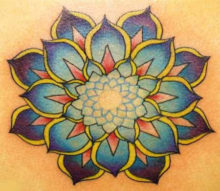 The lotus flower is a popular design for tattoos and art, as it is a daily reminder that perseverance and inner strength results in light and beauty. Getting a Lotus flower tattoo is a beautiful way to show your dedication to a Hindu or Buddhist faith. It is also a reminder to stay humble and focus on developing inner peace.
The lotus flower is a popular design for tattoos and art, as it is a daily reminder that perseverance and inner strength results in light and beauty. Getting a Lotus flower tattoo is a beautiful way to show your dedication to a Hindu or Buddhist faith. It is also a reminder to stay humble and focus on developing inner peace.
You can also develop more balance in your life with a tattoo of this flower because the eight petals represent all eight parts of a spiritual path. A lotus sends a message of gracefulness and love to everyone that sees it.
The colors of the lotus are also significant.
The sacred lotus is pink or white, and is a large flower whose petals can reach up to half a meter in diameter. Also known as the Indian or Oriental Lotus, every part of this plant is edible, and the sugared seeds are a treat during various festivals.
The red lotus is the ultimate symbol of the Sun and is the emblem of India.
The lotus depicted in stylized form in Egyptian friezes is the blue lotus, actually a form of water lily rather than a true lotus. As well as its ethereal color, this lotus contains a psychotropic substance called apomorphine, which no doubt contributes to its status as a sacred flower. The lotus eaters of Greek mythology, immortalized in Tennyson’s poem, “Song of the Lotus Eaters,” lived in a state of hedonistic bliss brought about by eating the seeds of this blue flower.
The white lotus flower and pink lotus flower from the Nelumbo family are seen as meaning purity and devotion. More passionately colored red, purple, and blue Lotus flower blooms can take on a spiritual meaning of ascension, enlightenment, or rebirth. A green Lotus flower is a beautiful gift for anyone trying to improve their life and start good habits.
According to the Language of Flowers, sometimes called florigraphy, a Victorian-era means of communication in which flowers and floral arrangements were used to send coded messages, allowing individuals to express feelings which otherwise could not be spoken, lotus flowers have the following meanings:
- Lotus (General) – Purity, Chastity, Eloquence, Forgetful of the past.
- Lotus (Flower) – Estranged love.
- Lotus (Leaf) – Recantation
